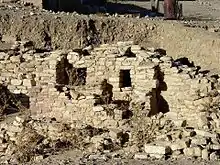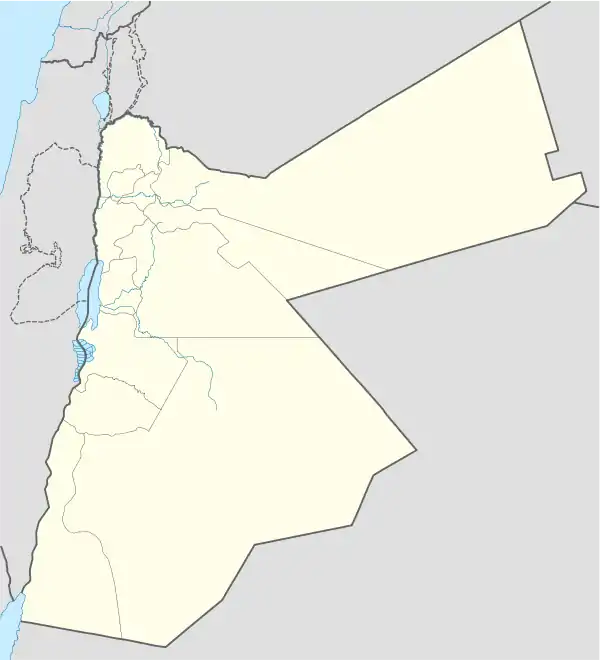Basta (Jordan)
Basta (Arabic: بسطة) is a pre-historic archaeological site in Ma'an Governorate, Jordan, 36 kilometres (22 mi) southeast of Petra.[1] It is named for the nearby contemporary village of Basta, which hosted a major Ottoman garrison during WWI and the Great Arab Revolt.[2] Like the nearby site of Ba'ja, Basta was built in c. 7000 BC and belongs to the PPNB (Pre-Pottery Neolithic B) period.[3] Basta is one of the earliest known places to have a settled population who grew crops and domesticated livestock. The houses in Basta were circular single family homes built from limestone, with wooden floors.[4] Because Basta's settlement predates pottery, all tools found there were made from stone and bone. Tools discovered at the site include millstones and granite arrowheads, the latter of which were noted for the quality of their craftsmanship.[5]
| Basta | |
|---|---|
 Basta | |
| Location | Jordan |
| Coordinates | 30°14′N 35°32′E |
 Location of Basta in Jordan | |
No dedicated tombs have been found at Basta. Instead, the people of ancient Basta buried their dead beneath their homes in order to better remember their ancestors. A number of animal-shaped figurines, depicting a sitting gazelle, an ox or cow head, a bear head, and a ram head, have been found at the site. These figurines are thought to have served a religious purpose.[6]
Basta lies at an altitude of around 1,460 metres (4,790 ft). The modern village is home to 1,491 people.[2]
Further reading
- Alt, K. W.; Benz, M.; Müller, W.; Berner, M. E.; Schultz, M.; Schmidt-Schultz, T. H.; Knipper, C.; Gebel, H. G.; Nissen, H. J.; Vach, W. (2013). "Earliest evidence for social endogamy in the 9,000-year-old-population of Basta, Jordan". PLOS One. 8 (6): e65649. Bibcode:2013PLoSO...865649A. doi:10.1371/journal.pone.0065649. PMC 3679157. PMID 23776517.
- Gebel, Basta II: The Architecture and Stratigraphy. Berlin 2006.
- Nissen, Basta I: The Human Ecology. Berlin, 2004.
References
- "دائرة الآثار العامة". www.doa.gov.jo (in Arabic). Archived from the original on 23 June 2018. Retrieved 9 July 2017.
- "الفرذخ.. وبسطة". الراي (in Arabic). 7 February 2012.
- Alt, Kurt W.; Benz, Marion; Müller, Wolfgang; Berner, Margit E.; Schultz, Michael; Schmidt-Schultz, Tyede H.; Knipper, Corina; Gebel, Hans-Georg K.; Nissen, Hans J.; Vach, Werner (2013). "Earliest Evidence for Social Endogamy in the 9,000-Year-Old-Population of Basta, Jordan". PLOS One. 8 (6): e65649. Bibcode:2013PLoSO...865649A. doi:10.1371/journal.pone.0065649. PMC 3679157. PMID 23776517.
- Jörg Nissen, Hans; Muheisen, Mujahed; Georg Gebel, Hans (2004). Basta: The human ecology. Berlin: Ex Oriente. ISBN 9783980757805.
- http://www.alhayatnews.com/jonews/local-news/71073.html
- Becker, Cornelia (1991). "The Analysis of Mammalian bones from Basta, a Pre-Pottery Neolithic site in Jordan : Problems and potential". Paléorient. 17 (1): 59–75. doi:10.3406/paleo.1991.4539. JSTOR 41492437.